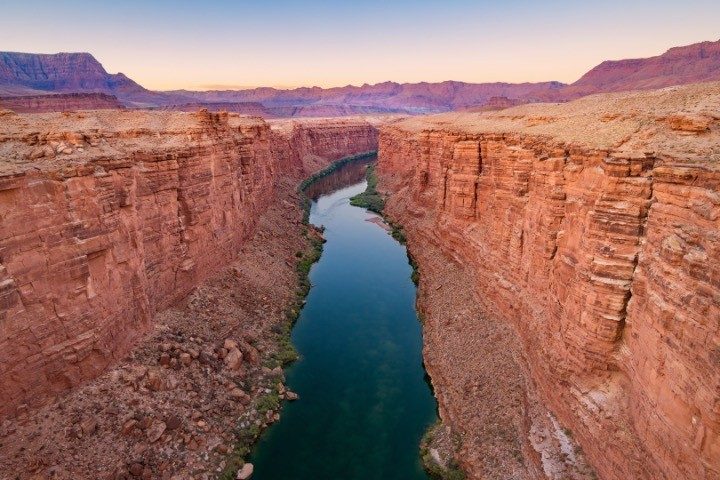
In June, seven states whose boundaries encompass the Colorado River basin were required by the Department of Interior to submit a plan to conserve up to four million acre-feet of water. The plan was to help ease the severe and historic drought that has made its mark throughout the Southwest.
The Colorado River basin states are California, Nevada, Arizona, Utah, Colorado, New Mexico, Wyoming, as well as the Mexican states of Baja California and Sonora. Since these states could not come up with an agreeable water conservation plan, the Department of the Interior took action on Tuesday and announced that it will work to protect the long-term sustainability of the Colorado River basin, which has dropped to record levels, by forcing the basin states to agree on a new water-sharing plan to replace a century-old agreement that was made when the river had more water.
In the Interior Department press release, Deputy Secretary Tommy Beaudreau said, “The worsening drought crisis impacting the Colorado River Basin is driven by the effects of climate change, including extreme heat and low precipitation. In turn, severe drought conditions exacerbate wildfire risk and ecosystems disruption, increasing the stress on communities and our landscapes. The Biden-Harris administration is taking an all-of-government approach to mitigating the drought, and the Interior Department is committed to using every resource available to conserve water and ensure that irrigators, Tribes and adjoining communities receive adequate assistance and support to build resilient communities and protect our water supplies.”
We could argue about climate change, as the effects from this drought the Southwest is suffering from are surely no different than other major droughts of the past. Even climatologists can’t agree.
Columbia Climate School says that, according to the journal Nature Climate Change, “The current drought that has enveloped southwestern North America for the past 22 years is the region’s driest megadrought — defined as a drought lasting two decades or longer — since at least the year 800.”
A report by the National Oceanic and Atmospheric Association (NOAA) Drought Task Force stuck to more certain facts in citing this as the worst drought the region has experienced since record-keeping began in 1895. “While the drought punctuates a two-decades-long period of declining precipitation in the Southwest that is ‘presumably natural,’ human-induced climate change exacerbated the current drought significantly by driving up average temperatures to scorching highs,” the report found.
Regardless of where you stand on the source and cause of the drought, it is clearly and significantly affecting the water resources of the Southwest. You can easily see the historically low levels of water at Lake Mead and Lake Powell, which retain a large portion of the Colorado River water. That is why the Department of the Interior took action on this long-term sustainability plan for the Colorado River System.
Per the press release:
“Every sector in every state has a responsibility to ensure that water is used with maximum efficiency. In order to avoid a catastrophic collapse of the Colorado River System and a future of uncertainty and conflict, water use in the Basin must be reduced,” said Assistant Secretary for Water and Science Tanya Trujillo. “The Interior Department is employing prompt and responsive actions and investments to ensure the entire Colorado River Basin can function and support all who rely on it. We are grateful for the hardworking public servants who have dedicated their lives to this work, and who are passionate about the long-term sustainability of Basin states, Tribes, and communities.”
A major part of the sustainability plan for the Colorado River basin is downstream releases from Glen Canyon and Hoover Dams — which created Lake Powell and Lake Mead. The releases will be reduced again in 2023 due to declining reservoir levels. These reductions represent the second year of additional shortage declarations, demonstrating the severity of the drought and critically low reservoir conditions.
Lake Mead’s 2023 projected elevation of 1,047.61 feet reflects its first-ever Level 2a Shortage Condition, which will require water savings contributions for the Lower Basin States and Mexico as follows:
- Arizona: 592,000 acre-feet, which is approximately 21 percent of the state’s annual apportionment
- Nevada: 25,000 acre-feet, which is eight percent of the state’s annual apportionment
- Mexico: 104,000 acre-feet, which is approximately seven percent of the country’s annual allotment
There is no required water savings contribution for California in 2023 at this time.
Bureau of Reclamation Commissioner Camille Calimlim Touton said, “Reclamation remains fully committed to working in a consensus manner across the Upper and Lower Basins, with Tribes, and with the country of Mexico. I am confident that, by working together, we can achieve meaningful change toward a sustainable future for the river that serves as the lifeblood of the American West.”
The Colorado River basin water shortages will continue until nature replenishes the parched Southwest. In the meantime, water conservation will be key to survival for the region. Agriculture — which is the largest user of water — and consumers of farm products will suffer the most.
It should be up to the individuals and local governments of the basin states to limit the use of water, if necessary, and develop water-efficient solutions for farming, business, and household use of the Southwest’s most sought-after natural resource.




